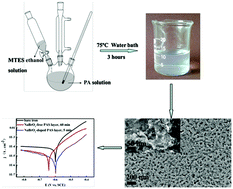Excellent anti-corrosive pretreatment layer on iron substrate based on three-dimensional porous phytic acid/silane hybrid†
Abstract
A novel, highly effective and environmentally friendly film-forming material, phytic acid (PA)/silane (denoted as PAS) hybrid with a three-dimensional (3D) network structure, was prepared through a condensation reaction of PA with methyltrihydroxysilane generated from the hydrolysis of methyltriethoxysilane (MTES). Two kinds of PAS-based pretreatment layers, namely NaBrO3-free and NaBrO3-doped PAS layers, were fabricated on iron substrates using the dip-coating method. SEM and AFM observations showed that the as-fabricated PAS-based layers possessed a 3D porous microstructure at the nanoscale and a rough surface morphology. X-ray photoelectron spectroscopic (XPS) and attenuated total reflection infrared (ATR-IR) spectroscopic characterization demonstrated that the above PAS layers bound to the iron surface via the –P–O– bond. Moreover, analyses of steady-state polarization curves and electrochemical impedance spectroscopic (EIS) data indicated that the corrosion rates of the iron substrates decreased considerably in the presence of the two PAS-based pretreatment layers. In particular, the NaBrO3-dosed PAS layer displayed the better corrosion resistance ability as well as maintaining the original microstructure and surface morphology. The PAS-based pretreatment layers are expected to act as substitutes for chromate and phosphate conversion layers and will find widespread application in the surface pretreatment of iron and steel materials due to the advantages of being environmentally friendly, the rapid film-forming process, and, especially, the nanoporous microstructure and rough surface morphology.


 Please wait while we load your content...
Please wait while we load your content...